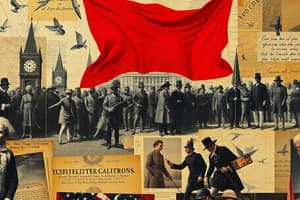Podcast
Questions and Answers
What were some of the interconnected factors that led to the French Revolution?
What were some of the interconnected factors that led to the French Revolution?
- Industrial revolution, cultural renaissance, and agricultural advancements
- Lack of foreign trade, overpopulation, and technological stagnation
- High taxes, food scarcity, and a feudal system favoring the aristocracy (correct)
- Political instability, religious conflicts, and excessive taxation
Who became a symbol of aristocratic decadence and was executed during the French Revolution?
Who became a symbol of aristocratic decadence and was executed during the French Revolution?
- Marie Curie
- Marie Antoinette (correct)
- Catherine the Great
- Queen Victoria
Which influential figure of the French Revolution was a leading member of the Committee of Public Safety?
Which influential figure of the French Revolution was a leading member of the Committee of Public Safety?
- King Louis XVI
- Napoleon Bonaparte
- Maximilien Robespierre (correct)
- Marquis de Lafayette
What were the revolutionary ideals that inspired the French to seek a more democratic and just society?
What were the revolutionary ideals that inspired the French to seek a more democratic and just society?
During which period did the Reign of Terror occur?
During which period did the Reign of Terror occur?
Who instigated the Reign of Terror during the French Revolution?
Who instigated the Reign of Terror during the French Revolution?
When was the Declaration of the Rights of Man and of the Citizen adopted?
When was the Declaration of the Rights of Man and of the Citizen adopted?
What did the Declaration of the Rights of Man and of the Citizen declare about people?
What did the Declaration of the Rights of Man and of the Citizen declare about people?
When did the Napoleonic Era take place?
When did the Napoleonic Era take place?
What did the Napoleonic Code enacted in 1804 do?
What did the Napoleonic Code enacted in 1804 do?
Flashcards are hidden until you start studying
Study Notes
Title: The French Revolution: A Comprehensive Overview
The French Revolution, which unfolded between 1789 and 1799, was a transformative period in European history. It marked a turning point in the political, social, and cultural landscapes of the time. In this article, we will delve into the causes, key figures, Reign of Terror, Declaration of the Rights of Man and of the Citizen, and the Napoleonic Era.
Causes
The French Revolution was largely a result of several interconnected factors. These include:
- Economic crises: High taxes, food scarcity, and an inefficient system of feudalism plagued the French people.
- Social inequality: France's class system favored the aristocracy and the clergy, leaving the Third Estate (the commoners) struggling to make ends meet.
- Enlightenment ideas: The revolutionary ideals of liberty, equality, and fraternity inspired the French to seek a more democratic and just society.
Key Figures
Numerous influential figures played a role in the French Revolution:
- Maximilien Robespierre: A leading figure of the Reign of Terror, Robespierre was an influential member of the Committee of Public Safety.
- Marie Antoinette: The queen of France, she became a symbol of aristocratic decadence and was executed during the Revolution.
- Napoleon Bonaparte: A military genius, Napoleon rose to prominence during the revolution and eventually became the Emperor of France.
- Georges Danton: A prominent figure in the early stages of the revolution, Danton was executed during the Reign of Terror.
Reign of Terror
The Reign of Terror was a period of intense political violence from 1793 to 1794. It was characterized by the deaths of thousands of individuals, including many prominent revolutionaries. The Reign of Terror was instigated by the Committee of Public Safety, which aimed to quash any counter-revolutionary activity.
Declaration of the Rights of Man and of the Citizen
The Declaration of the Rights of Man and of the Citizen was a document adopted by the National Constituent Assembly on August 26, 1789. It declared that all people, regardless of birth, religion, or social status, were equal in rights and duties. This document laid the foundation for modern democratic principles.
Napoleonic Era
The Napoleonic Era, which lasted from 1799 to 1815, was a period of unprecedented change in France. Napoleon, who came to power in 1804, reformed the French government and military, and embarked on an expansionist campaign that led to the creation of the First French Empire. The Napoleonic Code, enacted in 1804, replaced the old feudal laws with a more modern and egalitarian system.
In conclusion, the French Revolution was a complex and multifaceted event that had a profound impact on European history. It signaled the end of the old order and the beginning of a new era, characterized by democratic principles, nationalism, and a newfound sense of patriotism. The French Revolution will forever remain a cornerstone of modern history.
Studying That Suits You
Use AI to generate personalized quizzes and flashcards to suit your learning preferences.




